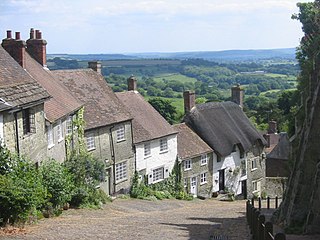
Shaftesbury is a town and civil parish in Dorset, England. It is situated on the A30 road, 20 miles west of Salisbury, near the border with Wiltshire. It is the only significant hilltop settlement in Dorset, being built about 215 metres above sea level on a greensand hill on the edge of Cranborne Chase.

Sherborne is a market town and civil parish in north west Dorset, in South West England. It is sited on the River Yeo, on the edge of the Blackmore Vale, 6 miles east of Yeovil. The parish includes the hamlets of Nether Coombe and Lower Clatcombe. The A30 road, which connects London to Penzance, runs through the town. In the 2011 census the population of Sherborne parish and the two electoral wards was 9,523. 28.7% of the population is aged 65 or older.

Dorchester is the county town of Dorset, England. It is situated between Poole and Bridport on the A35 trunk route. An historic market town, Dorchester is on the banks of the River Frome to the south of the Dorset Downs and north of the South Dorset Ridgeway that separates the area from Weymouth, 7 miles (11 km) to the south. The civil parish includes the experimental community of Poundbury and the suburb of Fordington.

Abbotsbury is a village and civil parish in the English county of Dorset. The settlement is in the unitary authority of Dorset about 1 mile (1.6 km) inland from the English Channel coast. The village, including Chesil Beach, the swannery and subtropical gardens, is owned by the Ilchester Estate, which owns 61 square kilometres of land in Dorset. In the 2011 census the civil parish had a population of 481.

Shaftesbury Abbey was an abbey that housed nuns in Shaftesbury, Dorset. It was founded in about 888, and dissolved in 1539 during the English Reformation by the order of Thomas Cromwell, minister to King Henry VIII. At the time it was the second-wealthiest nunnery in England, behind only Syon Abbey.

Anthony Ashley Cooper, 1st Earl of Shaftesbury PC FRS, 22 July 1621 to 21 January 1683, was an English politician and statesman from Dorset. He held senior political office under both the Commonwealth of England and Charles II, serving as Chancellor of the Exchequer from 1661 to 1672, and Lord Chancellor from 1672 to 1673. During the 1679 to 1681 Exclusion Crisis, he headed the movement to bar the Catholic heir, James II from the succession, often seen as the origin of the Whig party. He was also a patron of the political philosopher John Locke, with whom he collaborated with in writing the Fundamental Constitutions of Carolina in 1669.

Earl of Shaftesbury is a title in the Peerage of England. It was created in 1672 for Anthony Ashley-Cooper, 1st Baron Ashley, a prominent politician in the Cabal then dominating the policies of King Charles II. He had already succeeded his father as second Baronet of Rockbourne in 1631 and been created Baron Ashley, of Wimborne St Giles in the County of Dorset, in 1661, and he was made Baron Cooper, of Paulett in the County of Somerset, at the same time he was given the earldom.

Anthony Ashley Cooper, 3rd Earl of Shaftesbury was an English politician, philosopher, and writer.

Iwerne Minster is a village and civil parish in Dorset, England. It lies on the edge of the Blackmore Vale, approximately midway between the towns of Shaftesbury and Blandford Forum. The A350 main road between those towns passes through the edge of the village, just to the west. In the 2011 Census the civil parish had a population of 978.

Wimborne St Giles is a village and civil parish in east Dorset, England, on Cranborne Chase, seven miles north of Wimborne Minster and 12 miles north of Poole. The village lies within the Shaftesbury estate, owned by the Earl of Shaftesbury. A tributary of the River Allen, formerly known as the Wimborne, snakes its way through the village.

Donhead St Mary is a village and civil parish in southwest Wiltshire, England, on the county border with Dorset. The village lies about 2+1⁄2 miles (4.0 km) east of the Dorset town of Shaftesbury and stands on high ground above the River Nadder, which rises in the parish.

Nicholas Edmund Anthony Ashley-Cooper, 12th Earl of Shaftesbury, DL, also known as Nick Ashley-Cooper or Nick Shaftesbury, is an English peer, landowner and philanthropist. He succeeded his brother as Earl of Shaftesbury in 2005.
Shaftesbury is a town in Dorset, England

Anthony Ashley-Cooper, 9th Earl of Shaftesbury, was the son of the 8th Earl of Shaftesbury and Lady Harriet Augusta Anna Seymourina Chichester, the daughter of the 3rd Marquess of Donegall and Lady Harriet Anne Butler.

Gold Hill is a steep cobbled street in the town of Shaftesbury in the English county of Dorset. The view looking down from the top of the street has been described as "one of the most romantic sights in England."
The Bishop of Shaftesbury was an episcopal title which took its name after the town of Shaftesbury in Dorset, England.

St Giles House is located at Wimborne St Giles in East Dorset in England, just south of Cranborne Chase. It is the ancestral seat of the Ashley-Cooper family, which is headed by the Earl of Shaftesbury. The estate covers over 5,500 acres (22 km2).

The County Hall is a municipal facility at Colliton Park in Dorchester, Dorset, England.

Poole Civic Centre is an Art Deco municipal building in Poole, Dorset. Since 7 October 2019 the building has been a Grade II listed building. Also sometimes known as Poole Town Hall, the civic centre was the headquarters of Poole Borough Council until 2019.

Thame Town Hall is a municipal building in the High Street, Thame, Oxfordshire, England. The town hall, which is the meeting place of Thame Town Council, is a Grade II listed building.



















